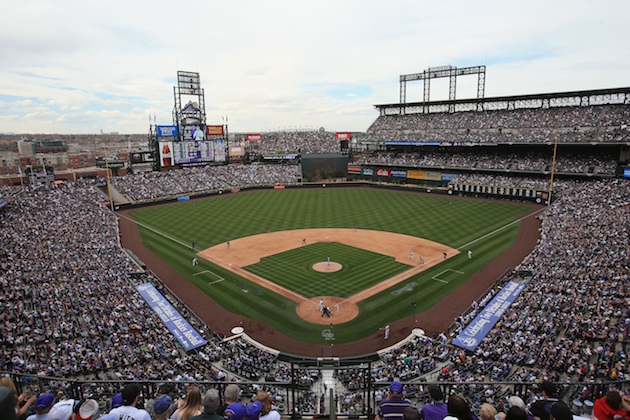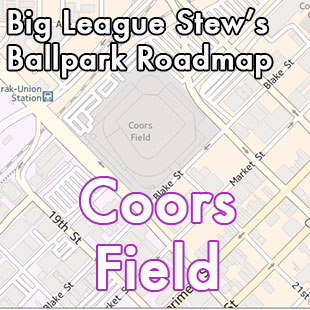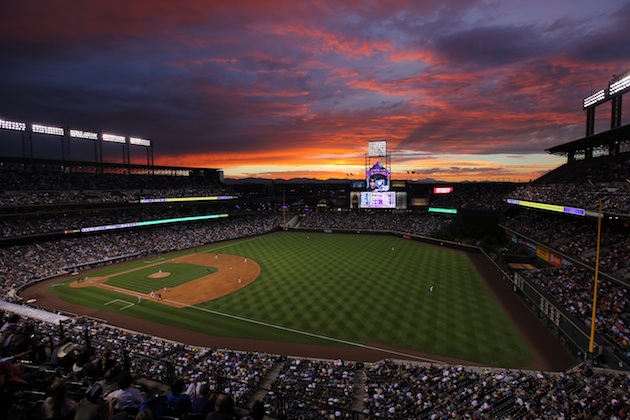
Have a baseball road trip coming up? Well, in a bid to help you with your upcoming journeys, Big League Stew has solicited the help of the locals. Over the next month or so, we'll be hitting up our usual guest blogger crew to feature 10 tips for enjoying each of the 30 ballparks like the locals do. Have a suggestion in addition to the ones listed here? Make sure to list it in the comments below.
Up next is our good friend Frank Schwab, a Denver resident who also helps man the Dr. Saturday blog here on Yahoo! Sports. Hooray for synergy!
Coors Field is best known for its thin air and skewing offensive statistics as a result of the ball flying out of the park, but it’s also really a beautiful place to watch a game.
The stadium was built in 1995, around the Camden Yards era, so it has that neo-retro feel with plenty of oddities that make it unique. The neighborhood surrounding the park is a great place to hang out before or after the game. The games might drive traditionalists and pitching coaches insane, and the dozen pitching changes might get tedious at times, but it’s a comfortable, accessible stadium in a wonderful setting.
Denver is a pretty good baseball town, too. The Broncos will always rule the city, though the Rockies are probably a closer second than you’d think for a 20-year-old expansion team. The fans are pretty knowledgeable and loyal. Colorado does well in attendance most years, even for a team that has never won a division title (but does have a World Series appearance, in 2007).
So if you’re ready to experience a beautiful ballpark and watch a game in which the home team’s seven-run lead doesn’t seem overly safe, this is the place.
 1. Get ready for scoring: You may have heard about this about Coors Field, but there are a lot of runs scored here. The first time my mom came from out of town to a Rockies game, the Tigers took an 8-0 lead by the fifth inning. I told her not to worry, that the Rockies would at some point probably at least get the tying run to the plate. The Rockies took a 10-8 lead in the sixth inning. That’s Coors Field. As the years pass, Hideo Nomo’s no-hitter at Coors Field on a miserable rainy September night in 1996 looks more and more like one of the most unbelievable feats in baseball history. Given the Rockies’ historically awful pitching and how the ball travels nine percent further in altitude, it’s a decent bet the home team may never throw one.
1. Get ready for scoring: You may have heard about this about Coors Field, but there are a lot of runs scored here. The first time my mom came from out of town to a Rockies game, the Tigers took an 8-0 lead by the fifth inning. I told her not to worry, that the Rockies would at some point probably at least get the tying run to the plate. The Rockies took a 10-8 lead in the sixth inning. That’s Coors Field. As the years pass, Hideo Nomo’s no-hitter at Coors Field on a miserable rainy September night in 1996 looks more and more like one of the most unbelievable feats in baseball history. Given the Rockies’ historically awful pitching and how the ball travels nine percent further in altitude, it’s a decent bet the home team may never throw one.
The scoring calmed down a little in 2002 when the Rockies started storing baseballs in a humidor, which adds moisture to the game balls. But on most days at Coors Field, you won’t be bored because there aren’t enough runs being scored.
2. The ballpark’s neighborhood is a destination in itself: Before Coors Field opened in 1995, the neighborhood around 20th St. and Blake St. was a mess. It wasn’t very safe and there was no reason to go. The stadium was the centerpiece of a dramatic rebirth in what is known as LoDo (lower downtown). There are dozens of trendy bars and restaurants in the area, and expensive lofts and condos to live in. Even on nights the Rockies don’t play, the neighborhood around Coors Field is the place to be in Denver. On game days, arrive early, stay after and have a great time.
3. Have a Blue Moon, since it was invented here: Coors Field is where Blue Moon beer was born. That alone should make the stadium a historic landmark. Brewmaster Keith Villa was the mastermind, and he came up with the concept of the beer and its orange-garished goodness at the Sandlot Brewery in the ballpark. The ballpark isn’t far from the town of Golden, the Coors brewing headquarters, and as such it’s a pretty good stadium for beer lovers. I mean, how many other ballparks have a microbrewery attached?
4. For $4, you can get a ticket: If you want to get into a game cheap, there aren’t many better deals than the Rockpile at Coors Field. The only problem is you’re roughly eight million miles from home plate, in a small section of seats high above dead center field. No matter, for $4 a seat you can’t go wrong. For big games (opening day and pretty much anything with fireworks) the line gets pretty long because all but a few reserved Rockpile tickets go on sale two-and-a-half hours before the game. So if you’re short on money and really want to get in the stadium you can go this route, just don’t expect to see much.
5. For the best view, sit on the first base side: If you go to a night game at Coors Field, try to sit on the first-base side, down the line and away from home plate a bit. Beyond the left field concourse you’ll get a fantastic view of the sun setting over the mountains, just past where the upper two levels end on the third-base side. The higher you sit in the stadium, the more of the mountains you can see. It’s one of the more picturesque views of nature you’ll find from a baseball stadium.

6. Really, it’s a good family experience: Coors Field is very kid friendly. It’s a pretty laid back crowd (insert Amendment 64 and Ballpark Holistic Dispensary joke here) and you’ll feel very comfortable bringing your family to the park. There’s a playground in the left field concourse, close to a concession stand just for kids named Buckaroos. The Rockies’ purple dinosaur mascot, “Dinger,” is available for pictures and autographs in the center field concourse in the early innings. If you're wondering why a baseball team has a giant purple dinosaur as a mascot, it's because they found a dinosaur fossil that was 66 million years old when they were building the park.
7. Yes, they still love Vinny Castilla here: If you want to get in good with the local fans, just drop a mention of the “Blake Street Bombers,” the nickname for the franchise’s early teams in the mid-1990s. Those teams weren’t particularly great – a 77-67 record in the strike-shortened 1995 season was the high point – but they were fun. And memorable. The Rockies recently had a bobblehead day for Vinny Castilla. Dante Bichette is the team’s popular hitting coach. Andres Galarraga was one of the Rockies’ first stars. And Larry Walker might still rank as the second most popular player in franchise history, although current shortstop Troy Tulowitzki might have overtaken him. Back in the pre-humidor days, that lineup just tried to pound teams into submission. They were always interesting, and still remembered well around here.
8. The Toddfather: So if Walker or Tulowitzki are battling for No. 2, who is the most popular player in team history? That one is pretty easy. Todd Helton broke into the majors with Colorado in 1997 and has played more than 2,100 games at first base for the Rockies. While the latter half of his career has been known for the nine-year, $141.5 million contract extension he signed in 2001 and the lack of production since (his last season with more than 20 home runs was 2004, his last 100-RBI season was 2003, from a player who had 91 home runs and 293 RBI in 2000 and 2001), he’s still a lock to be the first Rockies player to get his number retired.
 Look, you know a guy is a legend when he is playing first base, and out in the left field concourse there’s the Helton Burger Shack, where you can buy a Helton Burger, Helton Fries or Helton Onion Rings and a Helton Shake. Like the restaurant’s namesake, the food at the Helton Burger Shack is solid but definitely overpriced.
Look, you know a guy is a legend when he is playing first base, and out in the left field concourse there’s the Helton Burger Shack, where you can buy a Helton Burger, Helton Fries or Helton Onion Rings and a Helton Shake. Like the restaurant’s namesake, the food at the Helton Burger Shack is solid but definitely overpriced.
9. Who’s the statue of? Nobody, really: The Rockies don’t have a ton of history, but everyone wants a statue outside the stadium. So instead of having a statue of David Nied or Brad Hawpe commissioned, the Rockies have a statue of a generic baseball player. It’s titled “The Player,” in case you didn’t believe that it was generic. It’s a nice enough statue that has no historical significance whatsoever to the Rockies, but if you’re meeting a group of people before or after a game, that’s the landmark. It’s easy enough to find, standing outside the home plate entrance. You won’t miss it even if you’ve had too many Blue Moons beforehand.
10. What’s with the purple ring of seats?: A few rows from the top of the stadium, in the upper deck, there is a row of purple seats which stands out among the normal green seats. The significance is that row is exactly one mile above sea level. That’s a pretty unique thing about the stadium and a cool way to represent it, but you’re probably better off taking a glance at the far reaches of the upper deck from better seats. Make a mental note of the odd row of purple seats, and then watch some banjo-hitting infielder drill one 430 feet over the center field fence in the thin air.
What are your favorite tips for visiting Coors Field? Share them in the comments below!
Frank Schwab writes for Dr. Saturday, the college football blog on Yahoo! Sports
Previous parks: Citi Field, Marlins Park, Great American Ball Park, Petco Park,Comerica Park, Progressive Park, AT&T Park, Rogers Centre, Wrigley Field, O.Co Coliseum, Yankee Stadium
No comments:
Post a Comment